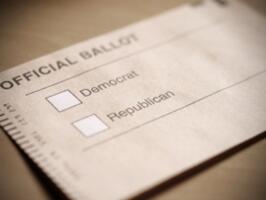What They Told Us: Reviewing Last Week’s Key Polls - Week Ending September 1, 2012
Just as Labor Day marks the end of summer for most Americans, it also signals the beginning of the presidential campaign season for many. Now they’ll focus on the race with Election Day looming just two months away.
So where do President Obama and Mitt Romney stand at this point? Heading into the Republican National Convention, the candidates have been even for months in the daily Presidential Tracking Poll. At week’s end, Romney was starting to enjoy a modest bounce from his convention. President Obama expects to do the same next week.
Our new Swing State daily tracking also finds the candidates running close in 11 states key to the election. All of the 11 Swing States were won by President Obama in 2008. The Rasmussen Reports Electoral College projections show the president with a 247 to 196 Electoral Vote lead, but seven critical states with 95 votes remain Toss-Ups. The Electoral College picture will likely shift a bit following the conventions, but it’s impossible to know what the shifts might be.
Still, voters by 20 points – 53% to 33% - predict that the president will be reelected. Republicans are expected to keep control of the House of Representatives, but voters are evenly divided over the future of the Senate.
Look for Scott Rasmussen and his guests to help sort this out when “What America Thinks” debuts this coming weekend on more than 50 television stations from coast to coast. Check the list of stations here.
Most voters are excited now about the chance to vote for either Romney or Obama, thanks to a big jump in enthusiasm among Republicans since the naming of Paul Ryan to their national ticket. So clearly GOP voters don’t think it’s over yet.
The wild card in the deck remains the economy, still the number one issue on voters’ minds as it has been for Obama’s entire presidency, and a plurality (44%) continues to rate the president's economic performance as poor. Thirty-five percent (35%) give him good or excellent marks in this area.
Voters still trust Romney more than Obama when it comes to handling the economy - but just barely - by a 48% to 44% margin. They have more confidence in the president when it comes to national security, and as for taxes, health care and energy policy, the presidential hopefuls are virtually tied, indicative of how close the race remains.
The bad news for Romney is that he had a 12-point lead on the economy in May, but that advantage has been declining ever since.
The bad news for the president is that the economic news remains grim. Only 16% of Americans believe that today’s children will be better off than their parents. Just 28% of voters think the country is heading in the right direction.
The Rasmussen Consumer and Investor Indexes, which measure daily confidence among both groups, continue to stumble along. Fifty-eight percent (58%) of consumers say the United States is in a recession, a view shared by 59% of investors.
Most Americans still believe it will take more than three years for the housing market to recover from the 2008 economic meltdown, and a sizable number continues to predict full recovery of the stock market will take at least that long, too.
Just over half (51%) believe a home is a family’s best investment, but most still don’t think it’s a good time for someone to sell their house. By comparison, 73% thought a home was a family's best investment in September 2008 just before the Wall Street meltdown.
Gas prices are going up again as summer ends, with 68% of American Adults now saying they are paying more for a gallon of gas than they were six months ago. Seventy-eight percent (78%) think it's likely that the price of gas will rise above $4 a gallon in the next few months, including 56% who say it's Very Likely.
Most voters still support repeal of the president’s national health care law and believe it will increase the deficit and the cost of health care.
More voters than ever consider Romney a conservative, but the president is still viewed as further to the political left than Romney is to the right. To put this in perspective, voters are more than twice as likely to describe themselves as fiscal conservatives as opposed to being fiscal liberals, but they break even when it comes to social issues.
But while many talk about the ideological gap or the gender gap between the candidates, Scott Rasmussen explains in a new radio update that there’s a growing generation gap in the mix. Yes, Obama still has a sizable lead among voters under 40 just as he did in 2008, but now seniors are moving to the Republican in numbers that far exceed their support for John McCain. (Listen to Scott’s radio updates three times daily Monday through Friday on a radio station in your area, courtesy of the WOR Radio Network.)
So what about the national political conventions on television and in the headlines this past week and next? Most voters aren’t watching much of them, regardless of their party affiliation, and over one-third of independent voters plan to tune them out completely.
The conventions are long past determining the presidential candidates of the major parties, and a lot of voters don’t have much use for them anymore. Forty-four percent (44%), in fact, consider the conventions a waste of time and money, but 35% disagree. Twenty-two percent (22%) are undecided.
Scott Rasmussen argues in his latest newspaper column that the conventions are “stark reminder of how out of touch our political system has become. … They only serve to remind us that what interests -- and entertains -- the political class has little to do with what America needs.”
One of the highlights of each party’s convention is the prime-time speech given by the presidential candidate’s wife. Voters remain evenly divided on the importance of the wives in determining how they will vote for president in November, but favorables for Michelle Obama and Ann Romney are up as the campaign begins in earnest.
Control of the Senate’s in play, too, this fall, with 33 seats up for grabs, only 10 of which are held by the GOP. The Rasmussen Reports Senate Balance of Power rankings show Democrats in good shape to hold 47 seats while Republicans can also count on 47. Six remain Toss-Ups and will determine which party controls the Senate.
But for the first time since November, Republicans and Democrats run even on the Generic Congressional Ballot. Republicans have held a modest lead on the ballot nearly every week since June 2009.
The number of voters nationwide who believe Congress is doing a good job remains in single digits.
Voters remain almost evenly divided over whether they would support a candidate who opposes all tax increases or one who would raise taxes only on wealthy Americans.
Sign up for The Rasmussen Reader, now just $24.95 for a 12-month subscription . Offer good through October 1, 2012.
The race to win an iPad is off with this past week’s debut of the Rasmussen Challenge. Check the leaderboard to see who’s ahead so far.
In other surveys last week:
-- This year has seen the highest number of reported West Nile Virus cases in the United States since the virus was first detected in 1999, according to the federal Centers for Disease Control. Most Americans are concerned about the spread of the virus, and a majority says they’d get vaccinated if it were possible. But Americans are not as enthusiastic about the government requiring vaccinations during a health emergency.
-- An overwhelming number of Americans nationwide have a favorable opinion of astronaut Neil Armstrong who passed away last weekend. Despite his famously guarded demeanor, most Americans correctly identify him as the first person to walk on the moon. Only a small percentage of Americans think the whole thing was staged.
-- Following Armstrong’s passing, just 41% of Americans believe the United States should resume manned space missions to the moon during the next decade. Nearly as many (37%) disagree.
-- With drought plaguing the Midwest, it may not be much of a surprise that over half (53%) of Americans are reporting that this summer has been hotter than recent summers.
-- Americans are highly concerned about the drought's impact on the economy, especially on food prices, and 76% think it is driving up food prices.
-- Fewer Americans say they have returned a lost wallet they found, but more have been on the receiving end of such honesty. Most adults still say that if they get extra change from someone, they give it back.
Subscribers to Rasmussen Reports receive more than 20 exclusive stories each week for less than a dollar a week. Please sign up now. Visit the Rasmussen Reports home page for the latest current polling coverage of events in the news. The page is updated several times each day.
Wall Street Journal profile called Scott Rasmussen "America's Insurgent Pollster." The Washington Post described him as "a driving force in American politics." If you'd like Scott to speak at your conference or event, contact Premiere Speakers Bureau.
Remember, if it's in the news, it's in our polls.
Rasmussen Reports is a media company specializing in the collection, publication and distribution of public opinion information.
We conduct public opinion polls on a variety of topics to inform our audience on events in the news and other topics of interest. To ensure editorial control and independence, we pay for the polls ourselves and generate revenue through the sale of subscriptions, sponsorships, and advertising. Nightly polling on politics, business and lifestyle topics provides the content to update the Rasmussen Reports web site many times each day. If it's in the news, it's in our polls. Additionally, the data drives a daily update newsletter and various media outlets across the country.
Some information, including the Rasmussen Reports daily Presidential Tracking Poll and commentaries are available for free to the general public. Subscriptions are available for $4.95 a month or 34.95 a year that provide subscribers with exclusive access to more than 20 stories per week on upcoming elections, consumer confidence, and issues that affect us all. For those who are really into the numbers, Platinum Members can review demographic crosstabs and a full history of our data.
To learn more about our methodology, click here.





